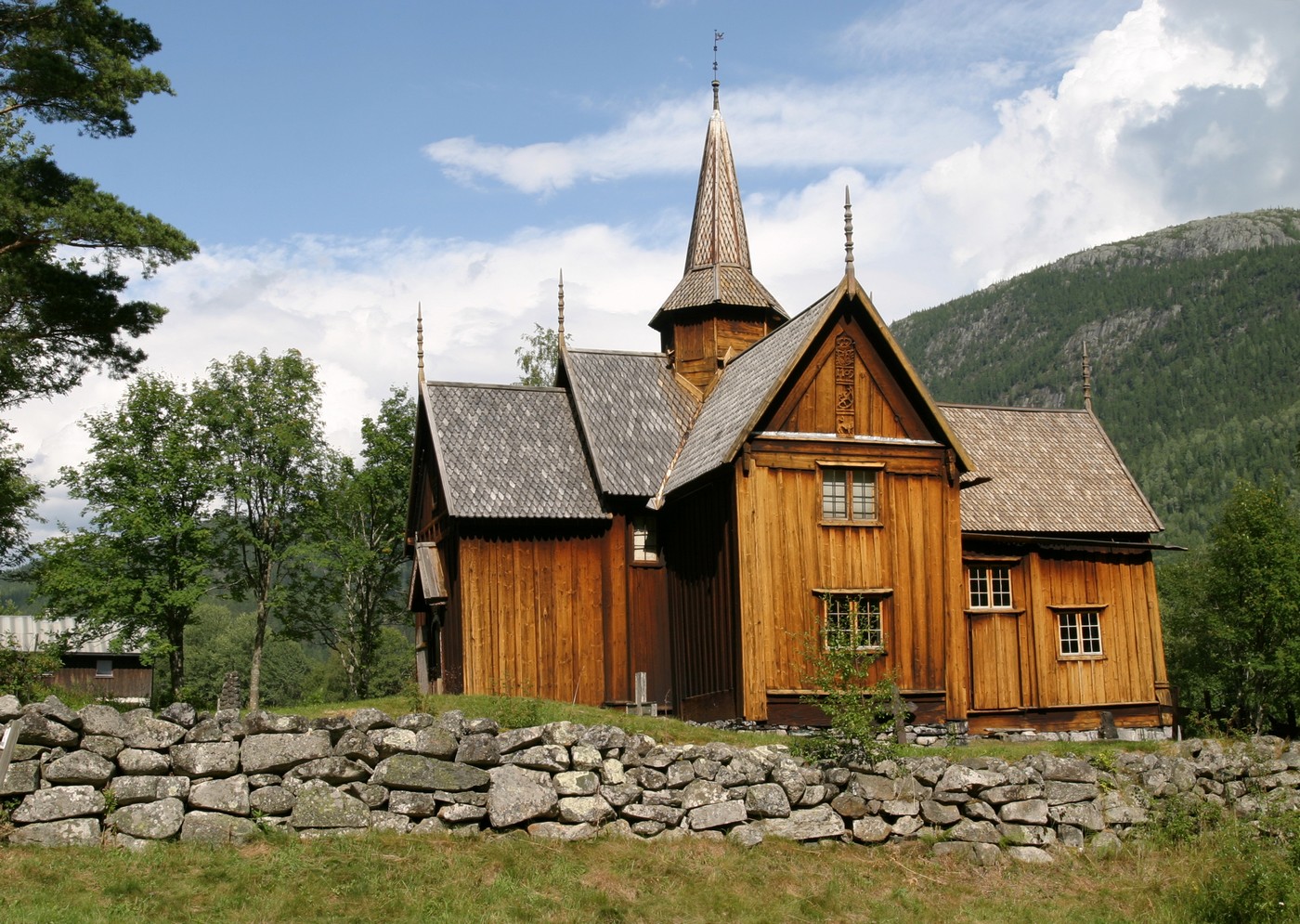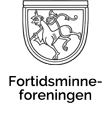Opening hours and admission fees
Opening hours in summer (18th juni to 14th august): All days from kl. 10AM to 6PM.
Admission fee (includes guided tour):
Singe ticket: NOK 50,-
Family: NOK 150,-
Groups (min. 10 pers.): NOK 40,- per person.
Tours can be booked at +47 57 67 88 40.

Nore Stave Church lies on a flat piece of land to the west side of the Kravik Fjord in Numedal. In 1880 a church was built a little to the north, at the old ferry crossing, where there is now a bridge. Because if this, the stave church became disused, and it was decided that it should be demolished. That it nevertheless has been preserved is first and foremost due to Professor Lorentz Dietrichson. He was at that time working with his book on Norwegian stave- churches and was aware of the importance and singularity of Nore Stave Church. The result was that he became the owner of the church on the condition that he took care of all maintenance. This was in 1888, and two years later he presented the church to the Norwegian Society for the Preservation of Ancient Monuments.
The church stands as it did when in use. Both inside and outside it is, however, strongly influenced by the great changes carried out in the period 1650 -1750, when it received its existing chancel, its two transepts, its porch in the west and its sacristy on the chancel’s north side.
The nave is the only part of the building that has preserved its original form. It is constructed as a normal stave building, but it has a couple of unusual features. The most eyecatching is the large post which stands in the middle of the room. It goes as a single mast right up to the ridge. At loft height, beams spanning horizontally bind the mid-post to the top beam of the side walls. As well as taking the place of one of the roofs paired rafters, its main function is to support a roof turret.
Image gallery
(click on an image to see a larger version)
The existing turret was built in 1730, but the mid-post is part of the original church and suggests that the nave has had a turret in the middle of the ridge from the beginning. From other stave churches we know of medieval roof turrets which rest entirely on the roof construction. When Nore and a few other churches have a mid-post, the reason has probably been to make the turret strong enough to take bell-ringing.
The nave has another unexpected feature in that the side walls are divided into three bays by two “staves”, which flank the openings into the transepts in the north and the south. The existing transepts are of log construction, the southern from 1709 and the northern from 1714. Investigations now show that the church had “stave” or vertical timber transepts before those of today were built. The two vertical posts (staves) which flank the entrance to each og the transepts have marks which show that they have been part of the sidewalls of older transepts. When these were demolished, some of their wall-planks were used as flooring in the transepts, and the planks show that the transepts had the same height as the nave. Also, the materials sensationally show that the transepts were terminated in a half-round apse to the north and the south, respectively. The apses were a little smaller than the transepts themselves. A beam spans the opening to the apses and between these and the main walls’ lintel beam there was a St. Andrews Cross. The transepts were covered by simple gable-ended pitch roofs in the north and south, which butted into the pitch roof of the nave, whilst the apses have had cone roofs.
The chancel today is the same width as the nave and about the same length, but originally it was much shorter. The breadth is indicated by the two original corner posts, which now flank the opening between the nave and the chancel. The corner posts show marks where the original chancel’s sidewalls were joined in. When the chancel was enlarged in 1683, the old wall-planks were reused in the north wall and the western part of the south wall. This shows that the chancel was approximately half the length of the existing and had “stave” walls the same height as the nave. The new chancel was, meanwhile, built about ½ metre lower, and the old wall-planks were cut to suit. The eastern part of the north wall in the existing chancel consists of curved planks which prove that the chancel also was terminated in a half-round apse in the east. As in the transepts, there is also here a beam spanning the apse opening, and the St. Andrews Cross which is fastened to the porch wall was originally placed between this beam and the lintel beam of the chancel’s eastern wall.
The outer arcade is also part of a medieval stave-church. Marks in the church’s wall-planks suggest that there has been a corridor around the whole church, and that the west arcade has had a built-up roof with a gable in front of the west entrance door. The external arcade must have been demolished in 1723, when the porch was built in front of the nave’s west front (the transepts had been added to in 1709). This resulted in the walls being panelled on the outside and the addition of larger windows than the small light-holes which were formally placed over the arcades roof and of which there is still a trace of up under the top beam. The other stave-churches in Numedal went through similar rebuilding in the period 1650 – 1750. The changes were aimed at bringing them more in line with the regular cruciform churches which were built in the eastern parts of the country at that time.
Nore Stave Church has also been a cruciform church of an unusual type. The chancel and transepts have formed the arms of the cross where the nave is the centre. The mid-post which bears the steeple marks the building’s mid axes.
There was a round-arched opening from the nave to the chancel to the east, and to the transepts in the north and the south. These were terminated in an apse, and over the doorways there sat St. Andrews Crosses. We know of no other similar church here or anywhere else, and with full right has been called unique among stave-churches.
Certain things suggest that the church achieved this form with a rebuilding some time in the middle-ages and that it was originally a simpler type with nave and chancel, but without transepts. The church’s age is difficult to ascertain. The west doorway has carved decoration with foliage and dragons which belong in style and time to about 1200. The same goes for the chancel’s south doorway, which has come to its existing place from the original chancel. It is greatly defaced, but the lintel which portrays dragons fighting is fairly well preserved. If it is the case that the church received its cruciform shape with a rebuilding, then this must have taken place sometime in the middle-ages.
One would expect to find a church in this part of Numedal before 1200, and it is possible that there was a church at Nore before the existing church was built. Some years ago an archaeological dig under the church floor found graves which were older than the church itself and can belong to a graveyard of an older church in the same site.
Interior
The church interior received its existing character under rebuilding during the 17th and 18th centuries, which were first and foremost in order to provide more room for the growing population. Fixed pews were set on the main floor and in the three new galleries in the north, the south and the west. The alter panel and pulpit also belong to this period. Nils Bragernæs painted the alter panel in1704 and is also the master of the painting of the Last Supper which is a copy of the old alter panel of 1633 from Kongsberg church (now in Lyngdal church). The pulpit has one panel with decorations from 1655 whilst the others have evangelist motives painted in the 18th century.
Most of the medieval inventory has disappeared, except for the baptism font which is preserved. The bowl is of talc-stone, whilst the foot is of a hollowed log. The two carved crucifixes, of which parts are to be found in the church, are presumable from the 13th century: one is defaced and the other has received new arms and is covered in thick layers of secondary paint.
The wall-paintings are from several periods. In 1655 the new nave and chancel were thoroughly decorated with arcading in the lower part, old testamentary scripts in the mid-part, whilst the upper part was painted with garlands of leaves, flowers and fruit. The west wall of the nave has a more baroque decoration with painted drapery below and large-leafed foliage above. Similar decoration is preserved on the walls in the south wing gallery. The panels of the north and the south wings under the gallery have rebus paintings which are copied from an illustrated bible printed in Copenhagen in 1710.
Under the pulpit and to the west in the nave, along the outer wall we can still find the remains of the wall-fasten benches from the middle-ages. They were the only seats, meant for the old and sick, the rest of the congregation was standing.
External links (in norwegian)
Riksantikvaren: Nore stavkirke – korskirke også i middelalderen
Fortidsminneforeningen: Nore Stavkirke
Kulturminnesøk: Nore stavkirke











